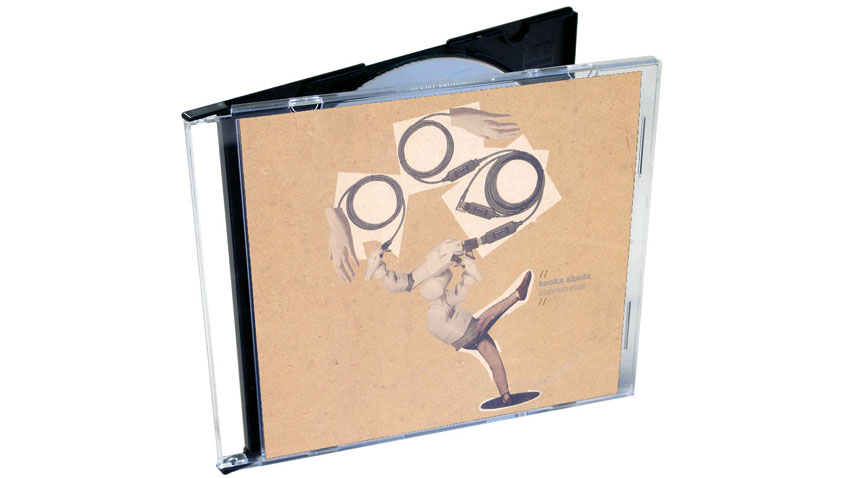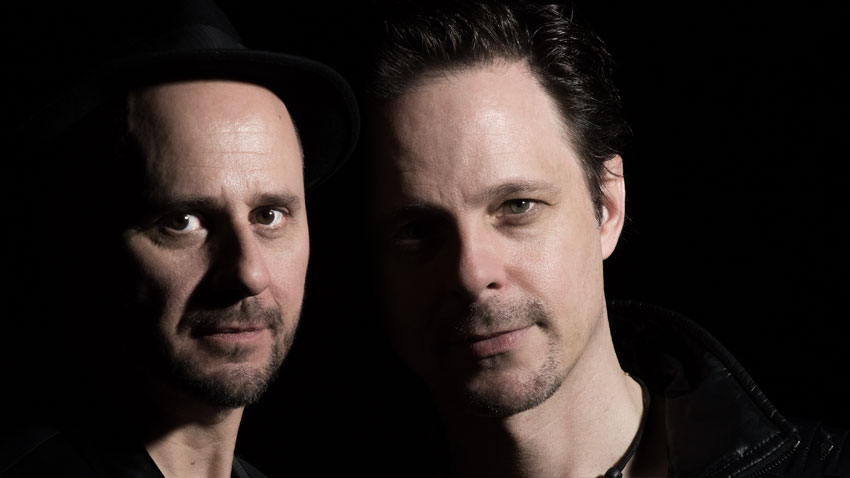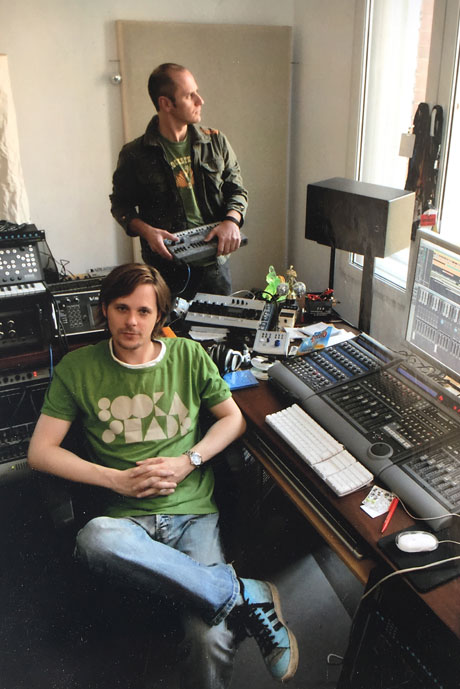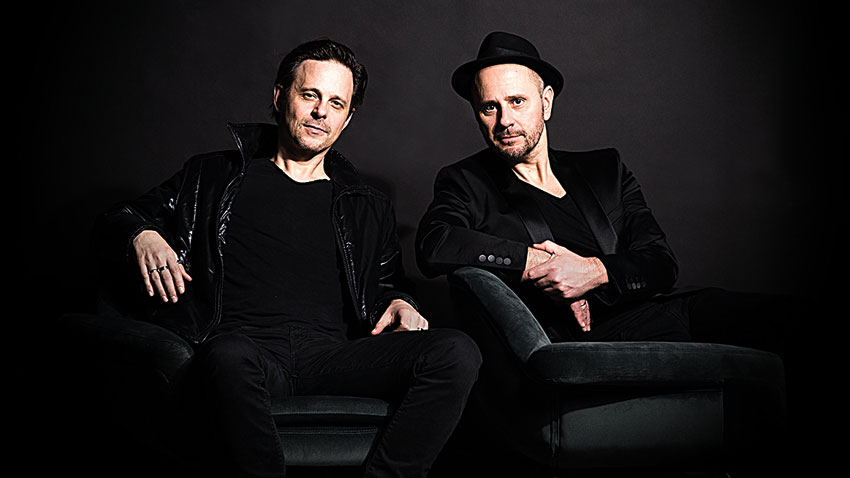Classic album: Booka Shade on Movements
Walter Merziger and Arno Kammermeier look back over their counter-club-cultural 2006 sophomore album

There’s something to be said for making music in a bubble - just you and your friends, writing the kind of stuff you want to hear. Everybody always copies each other anyway, right? Where’s the fun in that? That’s pretty much the lightbulb-lit convo the Booka Shade boys had with each other before they set to work on their second album.
Walter Merziger and Arno Kammermeier were completely uninspired by the club music of the time. ‘Schranz’ - a standardised form of monotonous techno - ruled the dancefloors. It was time for a change. It was time for a new movement. “We got together to do something new,” says Arno. “The predominant music had no melodies or basslines. We tried something more uplifting and positive. It didn’t really exist back then.”
Flushed with good vibes, they set to work on their new album, with the aim of bypassing the ‘go-to’ styles that dominated the era.“We were working in a different way,” says Arno. “Back then, everything was either schranz and hard techno, or very trancey, with a lot of delays, and deep bass drums with reverb, and all these clichéd FX. We wanted to get rid of all of that and get back to the vibe or texture that the groovy tracks of the past had.”
Movements showcased this glowing new approach - from the glorious disco ball illuminations of Night Falls, to the golden era trance shimmer of In White Rooms. Booka Shade had stepped into the light. “It was like we were all building a tree house in the sunshine,” says Arno. “It was really childlike. We didn’t care what happened outside.
“We were tired of what came before. Techno was boring. We decided to do things in a different way - no delays. No reverbs. The big chords and the big riffs - do them small.
“The belief in what we were doing was so strong that we could move mountains. We were in this wonderful bubble, and that’s what you can hear in the record.”
With that in mind, let's take a track-by-track tour of Movements with Walter and Arno as our guides…
Get the MusicRadar Newsletter
Want all the hottest music and gear news, reviews, deals, features and more, direct to your inbox? Sign up here.

Night Falls
Walter: “Our first album [Memento] was very introverted, small and intimate. When we played it out on stage it wasn’t energetic enough, so now we wanted to do music that was more riff-orientated and anthemic, where the chords were big, but not the sound. On this album, we played big chords but with very small elements. You can hear it in the middle part of Night Falls. It’s a classic Wagnerian approach. You could play it with brass!
“We’d take a small synthesiser plugin and play it with a kind of organ sound. We always tried not to ‘blow up’ the music, as it was in the trance world. We tried to get rid of all normal reverbs and delays, and concentrate on groove and atmosphere.”
Body Language (Interpretation)
Walter: “We didn’t want to put the original version on the album - it was too dancey, and it was already a big tune in 2005/6. It didn’t make any sense to put the known version on, so we did something with a different approach. It became more broken beat, acoustic, and took a different angle. The jazz guitar is from an early sample bank. Then we had a question and answering thing between the bassline and the guitar.”
Arno: “At the time, we were really crazy about ‘story-telling’ basslines. We’d take a bass, which would normally be in the bottom and background, and make it a very dominant element in a song. We found that very attractive.
“It also reflects the original Body Language sound aesthetic somehow, but now in a more relaxed way.”
Paper Moon
Walter: “It starts with a bar atmosphere. It’s a sound effects record that comes from Arno’s father’s vinyl collection.”
Arno: “We wanted something more deep and easy to listen to - more depth, more sonic depth. It was all about more layers of sound.
“It made sense to put it here on the album, as Paper Moon speaks a similar musical language to Body Language. The last two months or so of production were only spent on the track list - how we blend best from one track to another so it’s a journey. The entire album is one.
“Now we step away from doing interludes and spending so much time on transitions, as people can buy just one song these days.”
The Birds And The Beats/At The Window
Arno: “Ah, yes - the beautiful piano.”
Walter: “This was inspired by Herbie Hancock’s [seminal 1983 electro jazz fusion smash] Rockit. [Label mates] The M.A.N.D.Y. guys would play it and say, ‘Listen. It’s still so fresh!’. That inspired us to do something crazy, and a bit more weirdo-like, with just sounds and a broken beat and funk.
“I think this song is a combination of a lot of samples from all kinds of records. There’s a vocal in there as well, but I can’t tell where it came from. Maybe YouTube.”
Arno: “Because we were big fans of cinematic soundscapes we added this piano outro, with these playground noises and field recordings over the top. It gives the whole thing a bit more of a cinematic style and vibe.”
Darko
Walter: “We didn’t want these big, noisy sounds. Everything on this track is very stripped to the core, and it all comes from daHornet - this little five-buck plugin. It’s an emulation of the Wasp - it has that special sound, full of character. It was a brand new plugin, and it was very inspiring to play around with that little box.”
Arno: “Walter played the track to me for the first time in our hotel before a show at Benicàssim. We played it there for the first time on the beach. It was a great live track. It’s a straightforward sound, not very common in music now. It has a more verse/refrain arrangement. We were worried that it could be too poppy. It became a fan anthem, though.”
It was a great live track. It’s a straightforward sound, not very common in music now. It has a more verse/refrain arrangement. We were worried that it could be too poppy. It became a fan anthem, though.
Pong Pang
Walter: “This was the hardest track to do. It was just hours and hours of chopping around marimbas - it’s more or less marimba sounds, but in all kinds of ways. At that time we’d play the original sound, put reverb on it, reverse it, reverse it again, then add it to the original sound a bit early so the sound flies in all the time - it was quite nice.
“There was so much marimba and craziness in there, we had to add something to straighten it out, which is why you have this little bassline sound. That gives it a bit more of a techno feel.”
Arno: “Punky. It has a punky attitude. That was a lot of fun to play live.”

Mandarine Girl (Album Version)
Arno: “This pretty much reflects the energy of 90s clubbing, especially in Frankfurt at Sven Väth’s club, The Omen. We spent great times there.
“We tried to transport the energy of those rave times into this song with the majestic chords.”
Walter: “It’s a 90s trance anthem. It’s a super simple riff, then we tried to make it interesting, and not just use an arpeggiator and play it like a trance producer would.
“We were huge fans of James Holden’s remixes - The Sky Was Pink and Safari are outstanding tunes, with this very noisy but trancey production style, and we loved it. He was a big influence on Mandarine Girl. I think we even sampled the main clap in this song from him [laughs].”
Take A Ride
Walter: “This track is probably our fans’ least favourite. Nobody talks about it, ever. We weren’t even going to put it on the album, but it fit with the other tracks around it.
“It was dark, more cinematic, with atmosphere. We had a feeling that it would build towards the end of the album.
“We knew that we wanted something more serious, that wasn’t just nice basslines, that dives deeper into these ‘doomier’ sounds.”
Arno: “There are some nice resonance sounds in Take A Ride. We sent drums through a Roland SVC-350 Vocoder. In the middle of the track you can hear that more metallic sound.”
Wasting Time
Walter: “This was influenced by Ricardo Villalobos and his album Alcachofa - we always wanted to do something that had that organ sound.
“This is probably the only track with delay, which is in the bassline. We didn’t cut it - it’s just running on this groove. Then Arno came up with the lyrics and the melody.”
Arno: “We liked the vocoder a lot. We had a lot of it on Memento - just playing around with vowels and not singing too much. We didn’t want to have real vocals on the album, but a hint could be nice.
“There’s not a lot of lyrics, but it summed up our love for the club, and clubbing. You know, we are wasting time, but in a very nice, loving, way.”
In White Rooms
Walter: “You can see we are very bad A&R men because we wanted to drop this from the album and replace it with a B-side called Triple Identity. We thought it was too trancey and lame. Our manager said, ‘When you drop that, you have no manager anymore’. That made us leave it on [laughs].”
Arno: “We also thought we’d told the story of that with the riff in Mandarine Girl already. We were worried that it might be boring to do the same thing again.
“Obviously it became kind of a trademark sound - these storytelling basslines, turning into riff sounds.
“The riffs aren’t four-beat riffs. They have changes after 15 bars, then another change - it’s not simple to play. It sounds simple. There’s a lot of structure in the bass sound.”
We thought it was too trancey and lame. Our manager said, ‘When you drop that, you have no manager anymore’. That made us leave it on.
Hallelujah USA
Arno: “This features the sound of TV preachers, which is why it has that title.”
Walter: “The track came from a movie we wrote music for. The director was a huge fan of Aphex Twin and his rule was ‘no regular chords’, so we made weird layers and crazy stuff. No real regular instruments - mainly pure electronics. Just Aphex Twin thinking.
“For the album, we worked around that soundtrack version, adding different production, and a choir. Then some of the bass is played, and other low bits are sounds I looped back and forth to get a rhythm out of it. Then there are sounds we used when a cable broke and we played around with that noise too. Just experimenting, really.”

Lost High
Arno: “We like the idea of the ending of a night, and finishing on a peaceful atmosphere. The sun comes up, and the club is over. You’re leaving and coming home. It’s that blissful feeling that lingers on. For the first few albums we always had that dreamy, final song as the outro.”
Walter: “I was so proud about this ending that we’d done. It had all these strings coming in. It actually has a lot of reverb coming in. In these soundscape areas it was absolutely fine for us to use reverb, but not in dance tracks. It was too common at the end.
“This track was inspired by our last album, Memento, as the last track was Moonstruck and it was in the same direction as Lost High. We loved to end albums then with something more friendly, that leads you out into the morning.”


Future Music is the number one magazine for today's producers. Packed with technique and technology we'll help you make great new music. All-access artist interviews, in-depth gear reviews, essential production tutorials and much more. Every marvellous monthly edition features reliable reviews of the latest and greatest hardware and software technology and techniques, unparalleled advice, in-depth interviews, sensational free samples and so much more to improve the experience and outcome of your music-making.
"At first the tension was unbelievable. Johnny was really cold, Dee Dee was OK but Joey was a sweetheart": The story of the Ramones' recording of Baby I Love You
"Reggae is more freeform than the blues. But more important, reggae is for everyone": Bob Marley and the Wailers' Catch a Fire, track-by-track










